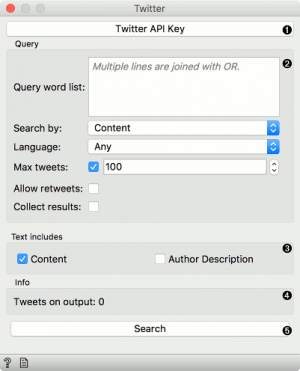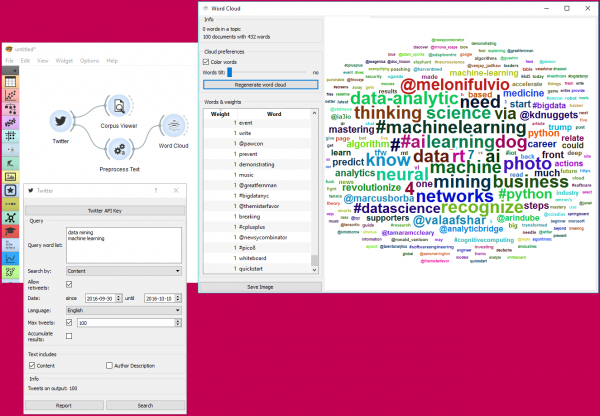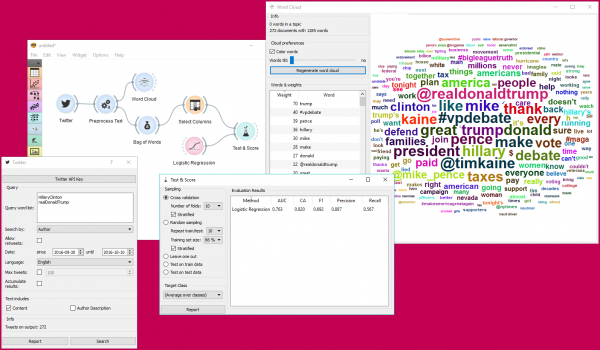Orange: Twitter
Sumber: https://orange3-text.readthedocs.io/en/latest/widgets/twitter-widget.html
Widget Twitter mengambil data menggunakan API Twitter Search.
Input
None
Output
Corpus: A collection of tweets from the Twitter API.
Widget Twitter memungkinkan kita untuk meng-query tweet melalui API Twitter. Kita dapat meng-query berdasarkan content, author atau ke dua-nya dan mengakumulasi hasil-nya jika kita ingin membuat dataset yang besar. Widget Twitter hanya mendukung REST API dan hanya mengijinkan untuk query sampai dua minggu ke belakang.
- To begin your queries, insert Twitter key and secret. They are securely saved in your system keyring service (like Credential Vault, Keychain, KWallet, etc.) and won’t be deleted when clearing widget settings. You must first create a Twitter app to get API keys.
- Set query parameters:
- Query word list: list desired queries, one per line. Queries are automatically joined by OR.
- Search by: specify whether you want to search by content, author or both. If searching by author, you must enter proper Twitter handle (without @) in the query list.
- Language: set the language of retrieved tweets. Any will retrieve tweets in any language.
- Max tweets: set the top limit of retrieved tweets. If box is not ticked, no upper bound will be set - widget will retrieve all available tweets.
- Allow retweets: if ‘Allow retweets’ is checked, retweeted tweets will also appear on the output. This might duplicate some results.
- Collect results: if ‘Collect results’ is ticked, widget will append new queries to the previous ones. Enter new queries, run Search and new results will be appended to the previous ones.
- Define which features to include as text features.
- Information on the number of tweets on the output.
- Run query.
Contoh
Dalam contoh ini, kita akan mencoba simple query. Kita akan mencari tweet yang berisi ‘data mining’ atau ‘machine learning’ dalam contant dan juga di retweet. Kita akan di batasi search hanya 100 tweet dalam bahasa Inggris.
First, we’re checking the output in Corpus Viewer to get the initial idea about our results. Then we’re preprocessing the tweets with lowercase, url removal, tweet tokenizer and removal of stopword and punctuation. The best way to see the results is with Word Cloud. This will display the most popular words in field of data mining and machine learning in the past two weeks.
Our next example is a bit more complex. We’re querying tweets from Hillary Clinton and Donald Trump from the presidential campaign 2016.
Then we’ve used Preprocess Text to get suitable tokens on our output. We’ve connected Preprocess Text to Bag of Words in order to create a table with words as features and their counts as values. A quick check in Word Cloud gives us an idea about the results.
Now we would like to predict the author of the tweet. With Select Columns we’re setting ‘Author’ as our target variable. Then we connect Select Columns to Test & Score. We’ll be using Logistic Regression as our learner, which we also connect to Test & Score.
We can observe the results of our author predictions directly in the widget. AUC score is quite ok. Seems like we can to some extent predict who is the author of the tweet based on the tweet content.



